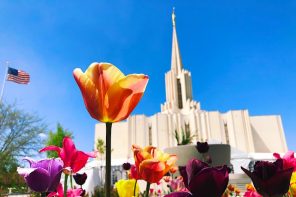When Harold Bloom published The American Religion in 1992, I was a college student at Brigham Young University, and I eagerly bought my own copy at the BYU bookstore. I didn’t always recognize the early, gnostic brand of Mormonism Bloom celebrated, but I knew it was important that finally a cultural critic of national standing saw nothing especially shameful or revolting in my religion’s astonishing nineteenth-century rise. Rather, according to Bloom, its imaginativeness made Mormonism a work of “authentic American genius,” an American original. Like jazz, perhaps.
Yesterday in the New York Times, Bloom returned to his affection for the “genius” of Joseph Smith, but this time in a bloated and platitudinous essay expressing (among other ill-defined sentiments) “dread” that Mitt Romney might gain the presidency and hence the now “plutocratic” LDS Church strengthen its grip. By my estimate, the dread-to-insight ratio in Bloom’s tedious essay runs about 10 to 1.
Few would argue that the faith Mormons live today is as Joseph Smith imagined it, and I know plenty of Mormons who regret the corporate shape and bureaucratic priorities of the contemporary LDS Church. But successful religions do age, after all. And blaming the emergence of Mitt Romney on Mormonism’s abandonment of its original nineteenth-century fervor is like blaming the rise of Joe Lieberman on Judaism’s abandonment of the eighteenth-century Polish shtetl. If only the Hasidim had won, there would be no Lieberman, after all.
Indeed, what Bloom holds up as the legacy of Joseph Smith “betrayed” by modern Mormonism is a fantasy glimpse of the moment of the religion’s inception. Mormon historian Ben Park reminded me in conversation yesterday that even Joseph Smith was dealing with the more mundane questions of organizational life by the mid-1830s, routinizing and establishing a multi-tiered organizational structure that persists to this day.
And modern Mormonism is as much the legacy of Church leaders like Brigham Young, the acknowledged architect of Mormonism’s American West empire. Or Wilford Woodruff, who issued the order ending the this-worldly practice of Mormon polygamy that secured Utah’s statehood and set Mormonism on a path towards national integration. Or David O. McKay, the twentieth-century LDS Church president, who dramatically expanded the Church’s worldwide missionary program and reduced Mormonism’s eccentric theological energies into a single correlated program of instruction.
Indeed, what makes contemporary Mormonism powerful is not the imaginative whimsy of its original doctrines but the sense of order and stability it offers to 14 million members around the globe. Mormon doctrine, the bureaucratized Church administration, and everyday lived emphases on preparedness and orthodoxy constitute an architecture of reassurance. And what others consider the audacious doctrine of eternal progression (often derided as the Mormon belief in “getting our own planets”) is actually a projection of the hunger for everyday stability (vested in the nuclear family) onto the eternities.
But Harold Bloom cannot write authoritatively about Mormonism since 1840. Because aside from a short season of “wandering” (as he describes it) about “the Southwest from 1989 to 1991” he does not know it. And while it’s terrific to see opinion page coverage of Mormonism at the Times move beyond Maureen Dowd’s sneering recap of Bill Maher’s latest stand-up routine, it would also be terrific to see the nation’s paper of record solicit its Mormon content from some of the nation’s most knowledgeable interpreters of Mormon political experience, like Penn’s Sally Gordon or Vanderbilt’s Kathleen Flake.
For those who tell the Mormon story best know that there is nothing exceptionally peculiar in Mormonism’s transition from renegade frontier religious movement to bureaucracy. Its mainstreaming and bureaucratization is as American a story as its origins. Intoning darkly the most sensational aspects of Mormon belief, a rhetorical tactic in which Bloom borrowed much from Hitchens—they tithe! they don’t allow non-Mormons (or less observant Mormons, in fact) in LDS temples! they believe they might become like God! very spooky!—only serves to alienate and antagonize Mormons.
It does not, however, grapple seriously with the even more ominous American crisis that makes a plodding, numbers-crunching, job-destroying suit like Mitt Romney (his record scrutinized in a sobering article on the Sunday Times’s front page) not only a plausible expression of modern Mormonism but one of the most plausible candidates for U.S. president.
This post has been changed from the original to correctly identify Woodruff.




